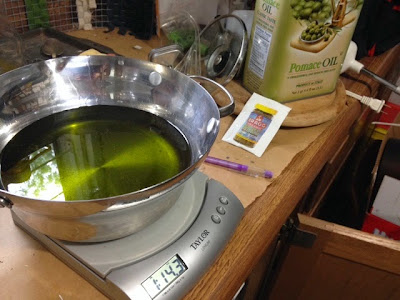It's All About the Skin that You're In - Making Basic Pure Olive Oil Soap
I've got a daily regimen to take care of the largest, often most ignored part of our human anatomy - our skin. Just before showering, I have a special natural bristle brush that I use to brush my skin, removing dead skin cells and stimulating cell reproduction. I then jump in the shower and wash myself with homemade olive oil soap, that I've made myself.
I've experimented with many soap recipes which call for a variety of oils, beer, goats milk etc. I've even rendered my own tallow from beef fat. My favourite recipe is straight olive oil soap and water. Despite whatever benefits people attribute to miscellaneous ingredients, I don't notice them. I just notice if the soap makes a nice lather, smells good and doesn't melt away in the shower.
Difficulty - Medium
Materials Needed:
1) 30 oz olive oil
2) 9 oz filtered water
3) 3.9 oz lye
4) 4 teaspoons essential oils
Tools
A plastic container to measure the lye
2) a plastics container to mix thee after and lye
3) a non-metal spoon for mixing the water & lye
A non-metal bowl to mix the water-lye mixture to the oil
5) a stick blender
6) mould
7) an old wood blanket
I measured out my oil (30 ounces) and placed on an electric burner in the basement.
Next, using a lye calculator from Bramble Berry, I measured my filtered water into a stainless steel kettle and the lye into a separate plastic container. Slowly, very slowly, add the lye (3.8 oz) to the filtered water while stirring. Do this in small increments as the lye may clump together and not dissolve. (Should this happen, the lye will not properly mix with the water and you'll need to start over.) NOTE: this step is extremely dangerous and goggles, gloves and proper attire should be worn at all times. Lye burns upon contact and accidents can happen. Be extremely careful not to splash or spill your mixture. Toxic fumes are also created during the first few minutes while the lye dissolves. Do this with a fan or near an window open. And ALWAYS add lye to water, NEVER ADD WATER TO LYE!!
Your lye/water mixture should reach about 150 degrees and needs to cool down and mixed with the oil only when both have reached between 110-120 degrees simultaneously. This is the tricky part - getting the timing right.
Once both your mixtures are a similar temp, slowly pour the water/lye mixture to the oil and stir. Once it's stirred in, you may use a stick blender to speed up the process. Cold Process soap making is fairly quick to trace (the time when the mixture reaches a pudding consistency and considered done) but pure olive oil soap can take much longer. The stick blender is your best friend.
After 10-15 minutes you will reach trace. I like to add my essential oils in just when I see the trace beginning. I probably could add them sooner but I don't want the heat of the mixture to damage the oils, and yet there needs to be enough time to thoroughly have them blended. (I added 2 teaspoons of each oil - rosemary and peppermint).
Pour half of your mixture into your mould. I am using a bread loaf mould for the first time. (I made my own mould from wood along time ago and I love it since it has a piece of wood which slides forward or backward to accommodate the batch size. Today I just wanted to try out a different mould.)
Pour half of your mixture into your mould. I am using a bread loaf mould for the first time. (I made my own mould from wood along time ago and I love it since it has a piece of wood which slides forward or backward to accommodate the batch size. Today I just wanted to try out a different mould.)
 |
| Essential oils and herbs. |
 |
| Folding in the herbs to the second half of the mixture. |
 |
| The herbs fully blended. |
 |
| Remaining soap mixture added to the mould before covering. |
 |
| Just poured loaf, ready to be wrapped in a blanket. |
 |
| Bars laid out in the drying rack. |
Leave it to dry on a rack for 4-6 weeks before using or gifting. Using soap before it's completely dried can burn your skin. Lye is still caustic and the chemical reaction takes very long to complete.
Check for an upcoming tutorial on olive oil and beeswax lotion making!











Comments
Post a Comment